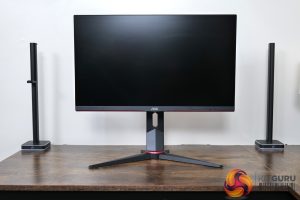Starting with the design of the Q24G2A, it's nothing we haven't seen before from AOC. In fact, I think if you imagined an archetypal AOC monitor, it's probably something a lot like this. That means a mostly matte black aesthetic, but with visible red accents alongside a wide v-shaped stand. Most of the red is on the back of the screen, apart from one ring around the base of the stand and a thin strip of red underneath the chin of the front panel.
It's absolutely fine in my opinion and the side and top bezels are all nice and slim. I would have preferred a square base instead of the v-shaped foot we have, but it's still fairly compact at 43cm across. Build quality could be improved however, as it does feel quite plasticky overall, though this isn't the end of the world provided you aren't constantly touching or moving the monitor.
The included stand offers the full array of ergonomic adjustments. This includes up to 130mm of height adjustment, 30 degrees of swivel both left and right, as well as tilt from -4 to 21.5 degrees. There's even full 90-degree pivot functionality so you can use this screen vertically if you want. Alternatively, third-party VESA 100×100 mounts are also supported.
Connectivity is an area where clear cutbacks have been made. The Q24G2A offers just two display inputs, with one HDMI 2.0 and one DisplayPort 1.2. The HDMI 2.0 port limits the refresh rate to 144Hz, but 165Hz is obviously possible vis DisplayPort 1.4. There are no other USB passthrough ports, USB-C or anything like that – a 3.5mm audio jack is the only other connection on offer. It really is a very basic setup, even for the price you’re not get much in the way of options here.
We can also note the five physical buttons on the underside of the front chin. These control the OSD, with no joystick on offer here from AOC, another cost-saving exercise.
 KitGuru KitGuru.net – Tech News | Hardware News | Hardware Reviews | IOS | Mobile | Gaming | Graphics Cards
KitGuru KitGuru.net – Tech News | Hardware News | Hardware Reviews | IOS | Mobile | Gaming | Graphics Cards
















